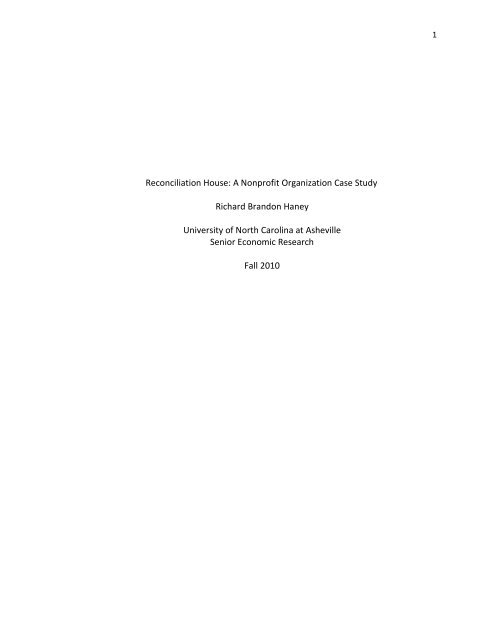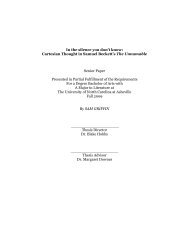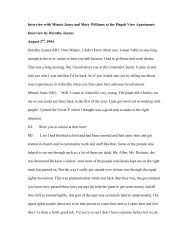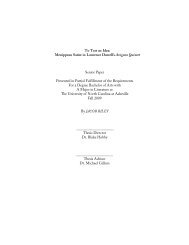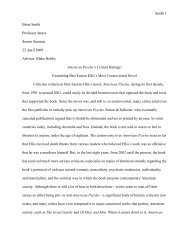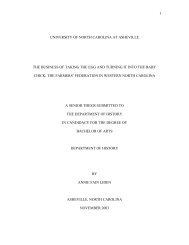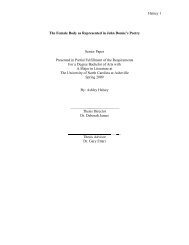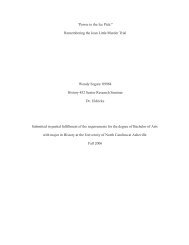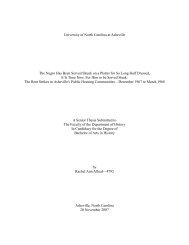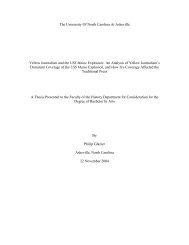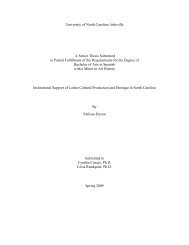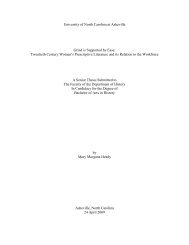Reconciliation House: A Nonprofit Organization Case Study Richard ...
Reconciliation House: A Nonprofit Organization Case Study Richard ...
Reconciliation House: A Nonprofit Organization Case Study Richard ...
Create successful ePaper yourself
Turn your PDF publications into a flip-book with our unique Google optimized e-Paper software.
1<strong>Reconciliation</strong> <strong>House</strong>: A <strong>Nonprofit</strong> <strong>Organization</strong> <strong>Case</strong> <strong>Study</strong><strong>Richard</strong> Brandon HaneyUniversity of North Carolina at AshevilleSenior Economic ResearchFall 2010
2Abstract:This paper examines <strong>Reconciliation</strong> <strong>House</strong>, a nonprofit charitable organization whichserves the community of Yancey County, North Carolina. It provides a brief history ofthe organization and examines the organization in the context of Yancey County’seconomy. This paper details <strong>Reconciliation</strong> <strong>House</strong>’s client services process, and explainsthe most significant trends and fluctuations in the financial data for the organization.I. IntroductionPoverty exists in varying degrees in most communities. Efforts to alleviate theeffects of poverty take various forms, such as government support, aid from friends andfamily, or aid from nonprofit organizations. This paper will examine the activities of onesuch nonprofit organization, <strong>Reconciliation</strong> <strong>House</strong>, located in Burnsville, North Carolina 1 .<strong>Reconciliation</strong> <strong>House</strong> is a nonprofit charity that distributes financial and physicalaid to qualifying residents of Yancey County, of which Burnsville is the county seat.<strong>Reconciliation</strong> <strong>House</strong> finances its operations in various ways. It receives donations fromindividuals and organizations such as churches (<strong>Reconciliation</strong> <strong>House</strong> is itself a religiousorganization); it operates a thrift store where it sells donated clothing, toys, furniture,appliances, and assorted other goods; and it receives government funding.1 Hansmann (2004) explores various theories as to why any economic activity takes the form of nonprofitorganization. The most applicable of these theories for the purposes of this paper is contract failure. Thistheory explains the existence of nonprofits as a solution to a principal-agent problem. Donors to anorganization such as <strong>Reconciliation</strong> <strong>House</strong> are not easily able to determine how their donations are beingused. The nondistribution restraint on nonprofits offers some assurance to donors that their donationsare not simply being used for the profit of the owners of the organization.
2<strong>House</strong> during this time, and in terms of the economic conditions of the community<strong>Reconciliation</strong> <strong>House</strong> serves, Yancey County.Section II of this paper provides background on Yancey County and<strong>Reconciliation</strong> <strong>House</strong>. Section III details the methods used in conducting the research forthe paper. The fourth section explains <strong>Reconciliation</strong> <strong>House</strong>’s client services. Sections Vand VI explain the most significant trends and fluctuations in <strong>Reconciliation</strong> <strong>House</strong>’sfinancial data, and section VII provides the conclusion and suggestions for furtherresearch.II. Background on Yancey County and <strong>Reconciliation</strong> <strong>House</strong>To more fully understand <strong>Reconciliation</strong> <strong>House</strong>, it is necessary to place it in thecontext of Yancey County. Yancey County is a rural community located in the mountainsof Western North Carolina (see Map 1). The population of Yancey County grew fromapproximately 15,500 in 1990, to approximately 18,500 in 2009. The poverty ratefluctuated from 18.7% in 1990, to 15.8% in 2000, and back up to 18.4% as of 2008 (seeChart 1). Median household income rose from $19,401 in 1990, to $29,674 in 2000, to$35,707 in 2009 (Chart 2). Yancey County’s unemployment rate has fluctuated from8.8% in 1991, to a low of 3.7% in 2000, to a high of 11.7% in 2009 (Chart 3). As can beseen from the graphs, Yancey County’s poverty rate and unemployment rate areconsistently above both the national and North Carolina rates, and its median
3household income is consistently below both the national and North Carolina medians.This implies a steady demand for charitable services.Dr. Gary West, minister of First Presbyterian Church, and a member of theYancey County Ministerial Association, founded <strong>Reconciliation</strong> <strong>House</strong> in 1982 inresponse to this demand. Members of the Ministerial Association saw the need for anorganization such as <strong>Reconciliation</strong> <strong>House</strong> due to the number of needy families whowere visiting various churches in search of aid. The members of the associationrecognized that both record keeping and distribution of aid could be better handledthrough a centralized location. Higgins Methodist Church offered the use of their oldparsonage for the new organization at the cost of one dollar per year (E. Miller and J.Miller, personal communication, September 23, 2010).Map 1Source: http://commons.wikimedia.org
6clients, such as food and financial assistance for fuel or electricity. This data revealscertain well-defined trends, and periodic fluctuations. Elizabeth Miller and John Miller,respectively the director and assistant director of <strong>Reconciliation</strong> <strong>House</strong>, wereinterviewed in order to explain these trends and fluctuations.<strong>Reconciliation</strong> <strong>House</strong> produces daily worksheets which record, among otherthings, the number of clients seen that day, the amount of financial assistancedistributed, and the number of clients who received food or clothing. I totaled thenumbers from the daily worksheets for each month, and then compared this data to themonthly unemployment data for Yancey County available on the Bureau of LaborStatistics’ website. The unemployment data is a proxy for fluctuations in demand for<strong>Reconciliation</strong> <strong>House</strong>’s services. Comparing the two data sets provides some indicationas to the responsiveness of <strong>Reconciliation</strong> <strong>House</strong> to these fluctuations.IV. An Explanation of <strong>Reconciliation</strong> <strong>House</strong>’s Client ServicesGary West operated <strong>Reconciliation</strong> <strong>House</strong> until 1989, when Elizabeth Millerassumed the directorship of the organization. At that time <strong>Reconciliation</strong> <strong>House</strong> wasquite small, with only one paid employee. Record keeping was done by volunteers; thebuilding, in addition to being smelly and mildewed, was in need of extensive repairs;and very little background check was done on prospective clients. All these things wouldchange under Miller’s leadership (E. Miller and J. Miller, personal communication,September 23, 2010).
7The first significant change implemented by Miller was a more extensivebackground check of clients. Previously, aid was distributed essentially on the honorsystem. Clients were taken at their word as to the nature of their need. Miller instituteda number of requirements in order to verify the client’s need for aid. Subsequentlyclients were required to provide proof of income through paycheck stubs or W2 forms.Clients were also required to provide documentation regarding the nature of theirfinancial aid, such as receipts from landlords and utility companies. The client interviewprocess has continued to evolve throughout <strong>Reconciliation</strong> <strong>House</strong>’s history. At presentclients must report, and substantiate with records, their various forms of income,including government aid such as food stamps and HUD housing assistance.Unemployed clients must be able to show that they have been looking for work.Disabled clients whose disability claims are not yet approved must providedocumentation from a physician that they are not able to work (E. Miller and J. Miller,personal communication, September 23, 2010).Clients must also report, and substantiate with records, their various expenses.These expenses are categorized as either necessary or unnecessary. Necessary expensesinclude, but are not limited to, rent or mortgage payments, utility payments,prescription drug purchases, insurance payments. Unnecessary expenses include, butare not limited to, alcohol and tobacco purchases, credit card payments, cable TVpayments. Unnecessary expenses also include excessive payments on many necessaryitems, such as rent or vehicle payments. Rent payments in excess of $400 areconsidered unnecessary, as are vehicle payments in excess of $250. A client’s eligibility
8for aid is then determined by adding their unnecessary expenses to their net incomeand then subtracting their necessary expenses. Based on these criteria clients eitherqualify for full assistance, limited assistance, one-time assistance, or no assistance. Withfull assistance clients are eligible for the full range of services provided by <strong>Reconciliation</strong><strong>House</strong>. Limited assistance qualifies clients for physical goods, such as food and clothing,but not financial assistance. One time assistance of physical goods is provided for clientswho do not quite meet the guidelines, and no assistance is given to those who are wellover the guidelines (E. Miller and J. Miller, personal communication, September 23,2010; J. Miller, personal communication, October 31, 2010).Given that the purpose of <strong>Reconciliation</strong> <strong>House</strong> is to give aid to those in need, itwould be interesting to examine how responsive <strong>Reconciliation</strong> <strong>House</strong> is to changes indemand for its services. Yancey County’s unemployment level serves as a proxy forthese changes. An increase in the number of unemployed people will likely increase thenumber of clients demanding <strong>Reconciliation</strong> <strong>House</strong>’s services. Likewise, an increase inthe number of workers without work may decrease donations. It seems likely, then, thatan increase in unemployment will result in an increase in the number of clients seen by<strong>Reconciliation</strong> <strong>House</strong>, but a decrease in the amount of financial assistance distributed bythe organization. To test these hypotheses I developed simple regression models using45 months of unemployment data, and data taken from <strong>Reconciliation</strong> <strong>House</strong>’s dailyworksheets regarding number of clients seen and the amount of financial assistancegiven.
9The following model is used to test the hypothesis that an increase inunemployment will increase the number of clients seen by <strong>Reconciliation</strong> <strong>House</strong>:C i = b o + b 1 UThe dependent variable, C, is the number of clients seen by <strong>Reconciliation</strong> <strong>House</strong> permonth. The independent variable, U, is Yancey County’s monthly unemployment level.Simple regression provides the following results:C i = 180.03 + 0.07U R 2 = 0.11, F-Stat = 5.51(t-statistic = 2.35)It is predicted, then, that an increase of 100 in the unemployment level, ceterisparabis, will result in an additional seven clients being seen at <strong>Reconciliation</strong> <strong>House</strong> in aparticular month.The next hypothesis, that an increase in the unemployment level for a particularmonth will result in a decrease in financial assistance for that month, will be tested withthe following model:FA i = b o - b 1 UThe dependent variable, FA, is the amount of financial assistance distributed by<strong>Reconciliation</strong> <strong>House</strong> in a particular month. The independent variable, U, is YanceyCounty’s monthly unemployment level. Simple regression provides the following results:FA i = 2577.42 + 2.17U R 2 = 0.01, F-Stat = 0.44(t-statistic = 0.66)This model shows the unemployment level to have a statistically insignificant effect onthe amount of financial assistance distributed by <strong>Reconciliation</strong> <strong>House</strong>.
10V. Building RepairsAs mentioned earlier, the <strong>Reconciliation</strong> <strong>House</strong> building was badly in need ofrepairs when Miller became director in 1989. Expenditures on building repairs providethe most dramatic fluctuations in the facilities and administration costs of <strong>Reconciliation</strong><strong>House</strong>, ranging from a low of $193 in 1992, to a high of $62,183 in 1997, and with amedian value of $1,983 (see chart 4). Building repair expenditures for 1994 totaled$10,988. These funds were used to enclose a car port which was adjacent to thebuilding. The enclosed car port was used for the storage of furniture, which<strong>Reconciliation</strong> <strong>House</strong> had previously been donating to clients rather than selling (E.Miller and J. Miller, personal communication, September 23, 2010; J. Miller, personalcommunication, October 14, 2010).In 1997 a dilapidated rear porch was removed from the building, and a two storyaddition was put in its place. There were two major reasons for this renovation: one, theporch was in disrepair and needed to be removed, and two, additional space wasneeded for <strong>Reconciliation</strong> <strong>House</strong>’s expanding operations. The cost of this renovationwas $62,183. Miller pursued numerous grants in order to pay for the renovation, hencethe spike in grants from $23,835 in 1996, to $57,386 in 1997. Miller was assisted in hergrant writing efforts by a class she took through the Community Foundation of WesternNorth Carolina, a nonprofit organization dedicated to supporting and promotingphilanthropy in Western North Carolina (E. Miller and J. Miller, personal communication,September 23, 2010).
11$70,000$60,000$50,000$40,000$30,000$20,000$10,000$-Building RepairsBuilding Repairs19911992199419951996199819992000200220032004200620072008Chart 4In 2005 building repairs totaled $10,405. These funds were used for the additionof an office. Space is limited in the building, with space needed for shopping space forcustomers, workspace for employees and volunteers to sort donations, and storage offood. This leaves little room left over in which to interview clients. For obvious reasonsprivacy is desirable for conducting such interviews. An office was added in 2005 for thispurpose. Prior to this addition interviews were being conducted in a location that washighly visible to shoppers at <strong>Reconciliation</strong> <strong>House</strong>. The office helps preserve the client’sprivacy and dignity (E. Miller and J. Miller, personal communication, September 23,2010).In 2006 a heat pump heating and cooling system was installed at <strong>Reconciliation</strong><strong>House</strong>. Prior to this installation there was no central air conditioning system for thebuilding. During the summer of 2006 there were days when <strong>Reconciliation</strong> <strong>House</strong> wouldclose due to the extreme temperatures inside the building. On other days shoppers
12would sometimes leave almost immediately after arriving due to the temperature. Theaddition of the heat pump alleviated this problem at a cost of just under $9,000 (E.Miller and J. Miller, personal communication, September 23, 2010).As 2007 approached, significant repairs were also needed for the roof and siding.The roof was leaking and shingles were falling off. The wood siding was rotting. The roofand siding were both replaced in 2007, at a cost of $19,138 (E. Miller and J. Miller,personal communication, September 23, 2010; J. Miller, personal communication,October 14 2010).Miller is not able to undertake significant expenditures, such as the buildingrepairs detailed above, simply at her own discretion. For expenditures over one hundreddollars, she must first be given approval by <strong>Reconciliation</strong> <strong>House</strong>’s Board of Directors.For renovations to the building, she must seek approval from United Methodist Church,the owner of the building. Once the necessary approval has been granted, Miller mustseek out sources of funding for the proposed expenditures. The reality of this processcan be quite complicated, as illustrated by the addition of the heat pump in 2006 (J.Miller, personal communication, October 14, 2010).For this expenditure, Miller was given approval by the Board and by UnitedMethodist Church, as is the normal process. Securing the funds for such a project,however, is often a lengthy process. Given the pressing need for the heat pump—<strong>Reconciliation</strong> <strong>House</strong> was closing on some days and losing customers on others due tothe heat—this lengthy process was problematic. In order to have the heat pumpinstalled as soon as possible, Miller first secured a loan from her husband to pay for the
13heat pump. Next, she applied for a loan from a local bank. With this loan she repaid herhusband. Miller also applied for a grant from the Janirve Foundation. When the fundsfrom this grant became available, Miller repaid the loan from the bank. The Board ofDirectors was kept informed, and approved, of the unusual circumstances surroundingthe funding of this project (E. Miller and J. Miller, personal communication, September23, 2010; J. Miller, personal communication, October 14, 2010).VI. Total Revenue, Salaries, and Total Ministry<strong>Reconciliation</strong> <strong>House</strong>’s financial data reveal three interrelated overarchingtrends: steady increases in total revenue, total administrative costs, and total ministry.Ministry expenditures, which are the various forms of aid <strong>Reconciliation</strong> <strong>House</strong>distributes to its clients, are obviously dependent on total revenue. The steady increasein total revenue resulted in an expansion of <strong>Reconciliation</strong> <strong>House</strong>’s workforce. Thisexpansion accounts for the steady increase in total administrative costs, as payroll is thelargest component of total costs. Chart 5 illustrates the rise in total revenue, totaladministrative costs, and total ministry. Charts 6, 7, and 8 illustrate how the proportionof each individual component of total revenue, total administrative costs, and totalministry has changed over time.
14Chart 5100%90%80%70%60%50%40%30%20%10%0%Revenue Sources as Proportion ofTotal Revenuetax refundthrift saleschurchesgrantsindividulas199119921993199419951996199719981999200020012002200320042005200620072008Chart 6
15Individual Costs as Proportion ofTotal Administrative Costs100%90%80%70%60%50%40%30%20%10%0%199119931995199719992001200320052007utilitesbuilding repairsgeneral administrativecostspayrollChart 7Ministry Categories as Proportion ofTotal Ministry100%90%80%70%60%50%40%30%20%10%0%1991 1993 1995 1997 1999 2001 2003 2005 2007gasolinemiscellaneousrent and mortgagewaterhot mealsfuelelectricitymedicine and transportationemergency shelterfoodChart 8
16In 1991 total revenue was $54,689. By 2008 this figure had risen to $191,402 2 .Miller attributes this steady rise in revenue to a number of factors, including buildingrepairs, addition of new employees, and increased public awareness of <strong>Reconciliation</strong><strong>House</strong>. The spike in 1997 was caused by the grant which Miller secured to help pay forbuilding repairs for that year (E. Miller and J. Miller, personal communication,September 23, 2010).According to Miller, the cumulative effect of the building repairs has been tocreate a much more enjoyable shopping experience for the customers of <strong>Reconciliation</strong><strong>House</strong>. Shoppers at <strong>Reconciliation</strong> <strong>House</strong> no longer have to contend with bad smells,mold, mildew, uncomfortable temperatures, or a leaking roof. As a result, more peopleshop at <strong>Reconciliation</strong> <strong>House</strong>, and they spend more time shopping. The additions whichhave been added have enabled <strong>Reconciliation</strong> <strong>House</strong>’s labor force to process a greateramount of donations, and more space in which to display those donations. All thesefactors help to explain the steady increase in thrift sales over the years, which has beena main source of the increase in total revenue.As stated previously, the number of paid staff members of <strong>Reconciliation</strong> <strong>House</strong>has increased from one in 1989, to six in 2010. Initially Miller requested an additionalemployee to help both in the thrift shop and to interview clients. As public awareness of2 James (1983) explores the role of cross subsidization in nonprofit growth. Many nonprofits engage inactivities for which they earn a profit, such as thrift sales, in order to subsidize services for which they losemoney. Decisions about the mixture of profit-making and profit-losing activities will be made so as tomaximize the utility function of the organization. James develops a mathematical model to illustrate thisprocess.
17<strong>Reconciliation</strong> <strong>House</strong> increased over the years the organization began to receive moredonations, and to serve more clients. These changes prompted the addition of otheremployees to <strong>Reconciliation</strong> <strong>House</strong>’s staff. With the additional staff, donations are ableto be more quickly sorted, cleaned if need be, priced, and displayed for purchase. Alsowith the additional staff comes an increase in payroll. Payroll has increased from$10,442 in 1991, to $104,404 in 2008 3 . It is Miller’s goal for thrift shop sales tocompletely cover the cost of <strong>Reconciliation</strong> <strong>House</strong>’s payroll 4 (E. Miller and J. Miller,personal communication, September 23, 2010).As noted above, the addition of staff members contributes to an increase in totalrevenue, which in turn enables an increase in total ministry. <strong>Reconciliation</strong> <strong>House</strong>’s totalministry has increased from $29,251 in 1991, to $68,331 in 2008. There are significantfluctuations in this data. Total ministry increases dramatically from 2000 to 2002, fallssteeply in 2004, significantly increases again through 2006, and falls once again in 2007.These fluctuations can be largely explained through variations in total revenue, andthrough variations in <strong>Reconciliation</strong> <strong>House</strong>’s yearly deficits and surpluses. The deficitsare the result of bills which have not been paid by the end of the fiscal year. Surplusesare generated by donations which have been restricted for the purchase of fuel oil, but3 It should be noted that <strong>Reconciliation</strong> <strong>House</strong>’s labor force consists mainly of volunteers. Obviously thevalue of the volunteer labor is not captured in the payroll expenditures.4 Parsons (2004) discusses the trend towards increased professionalization in UK charity shops. Asdemand for the services of the parent charities of these shops increases, the shops are pressured toincrease profits. Professionalization of the shops is seen as a way to accomplish this goal.Professionalization includes factors such as paid staff, emphasis on previous retail experience in hiringstaff, and collecting and analyzing sales data. Miller’s decisions to make building improvements and toadd staff are both examples of professionalization.
18which have not been distributed by the end of the fiscal year (J. Miller, personalcommunication, October 29, 2010).In 2000 ministry expenditures totaled $27,373, and rose to $35,089 in 2001, a28% increase. This increase was enabled by a $25,670 increase in total revenue, whichwas the result of a large increase in donations from individuals. The next year, 2002,total ministry increased to $50,934, a 45% increase over the previous year’s total. Thisincrease was the result of a $12,849 surplus in 2001, combined with a $5,080 deficit for2002. Total ministry expenditures dropped to $40,896 in 2004, from $52,599 in 2003.This decrease was the result of a $7,460 deficit from 2003, combined with an increase of$5,938 in administrative costs for 2004. Total ministry increased by 54% in 2005, to$62,776. This increase was enabled by an increase in grant revenues for 2005 of$20,308.It should be noted that <strong>Reconciliation</strong> <strong>House</strong> distributes aid which is notcaptured in its ministry totals. For example, <strong>Reconciliation</strong> <strong>House</strong> donates clothing to itsclients. This clothing was first donated to <strong>Reconciliation</strong> <strong>House</strong>. Since the clothing wasnot purchased by <strong>Reconciliation</strong> <strong>House</strong>, the value of the clothing is not captured in thefinancial statements. <strong>Reconciliation</strong> <strong>House</strong> also donates firewood to its clients. Thefirewood is donated to <strong>Reconciliation</strong> <strong>House</strong> by a local resident. The value of this woodis also not captured in the financial data.
19VII. Conclusion and Suggestions for Further ResearchThe purpose of this paper has been to identify and explain trends andfluctuations in the sources of revenue and expenditures for <strong>Reconciliation</strong> <strong>House</strong>.Building repairs provide the most dramatic source of fluctuations. While building repairsdo constitute a major source of expenditures for <strong>Reconciliation</strong> <strong>House</strong>, it should benoted that the cost of these repairs would be far exceeded by the cost of leasing acomparable building. <strong>Reconciliation</strong> <strong>House</strong> currently only pays one dollar per year forthe building.The three overarching trends of increases in total revenue, payroll, and totalministry are interrelated. Additional staff members obviously increase payroll, but alsoenable an increase in revenue. Ministry expenditures are dependent on revenue.<strong>Reconciliation</strong> <strong>House</strong>’s total revenue and payroll have increased dramatically since 1991.Total ministry has also increased significantly, but not at the same dramatic rate asrevenue and payroll.There are several possibilities for additional research. This paper has made noattempt to evaluate how well <strong>Reconciliation</strong> <strong>House</strong> performs its economic role. Furtherresearch could attempt to perform such an evaluation 5 . Any attempt to perform such anevaluation would need to account for the full value of the goods and services which<strong>Reconciliation</strong> <strong>House</strong> provides. The value of goods which are donated to <strong>Reconciliation</strong>5 Hager and Greenlee (2004) examine the complications inherent in using financial data to evaluate theeffectiveness of a nonprofit organization. First, financial data is not especially useful in comparingnonprofit organizations which provide different types of services, such as symphonies and homelessshelters. Second, the financial data does not necessarily indicate how well the organization is achievingthe outcomes it desires. Finally, an emphasis on financial data can lead to nonprofits changing behavior inways to improve their financial numbers, but which do not actually help the organization achieve its goals.
20<strong>House</strong>, such as clothing and firewood, and which <strong>Reconciliation</strong> <strong>House</strong> in turn donatesto its clients, are not captured in <strong>Reconciliation</strong> <strong>House</strong>’s financial records. Additionalresearch could attempt to place a value on these goods.Additional research could also compare <strong>Reconciliation</strong> <strong>House</strong> to other nonprofitorganizations 6 . Comparing the proportion of revenue which is spent on operating costs,and the proportion which is spent on ministry, to the same proportions fororganizations of similar size and function would help provide a basis on which to judge<strong>Reconciliation</strong> <strong>House</strong>’s performance (see Chart 8). This would be an imperfect meanswith which to make a judgment, however. First, <strong>Reconciliation</strong> distributes goods whosevalue is not captured in the financial numbers. Second, emphasizing such ratios couldlead to changes that would improve the ratios, but would not improve <strong>Reconciliation</strong><strong>House</strong>’s ability to serve its clients. For example, <strong>Reconciliation</strong> <strong>House</strong> could eliminate itsclient interview process and provide assistance on a first come first serve basis. Such anarrangement would be much less labor intensive and payroll expenditures could beexpected to decrease accordingly, enabling an increase in ministry expenditures. Suchan arrangement would fail to identify and give aid to those most in need, however.Researchers attempting to evaluate how well <strong>Reconciliation</strong> <strong>House</strong> performs itseconomic function will have to contend with this and similar problems inherent in thestudy of nonprofit organizations.6 Hager, Pollak, and Rooney (2000) develop a regression model to explain the variation of suchproportions among nonprofit organizations. The variables of size, age, and subsector are used in themodel. The authors found size and subsector to be significant variables, while age was found to beinsignificant. The adjusted R² for this model is only 0.15, however, leaving much variation to be explained.
21100%90%80%70%60%50%40%30%20%10%0%<strong>Reconciliation</strong> <strong>House</strong>'sAdministrative Costs and Ministry asa Proportion of Total Revenue1991 1993 1995 1997 1999 2001 2003 2005 2007MinistryAdministrationChart 8
22Appendix ARevenue1991 1992 1993 1994 1995 1996Individuals $9,245 $4,148 $8,006 $6,828 $7,162 $8,782Grants $26,672 $28,902 $26,063 $24,109 $17,636 $23,835Churches $9,485 $11,164 $10,896 $13,971 $10,659 $12,609Yard Sales $2,193 $2,177 $1,207 $6,351 $5,467 $4,063Thrift Sales $6,782 $7,506 $9,572 $10,599 $16,435 $22,350Sales TaxRefund/Other$312 $0 $555 $1,125 $968 $895Total Revenue $54,689 $53,897 $56,298 $62,984 $58,327 $72,534Facilities andAdministrationPayroll $10,442 $14,554 $15,245 $20,431 $21,205 $28,382GeneralAdministrativeCosts$7,131 $8,685 $6,264 $6,835 $8,512 $8,521Building Repairs $463 $193 $995 $10,988 $4,622 $1,241Utilities $346 $810 $1,280 $1,156 $878 $1,637Total FacilitiesandAdministration$18,382 $24,242 $23,784 $39,410 $35,218 $39,780MinistryFood Purchase $8,026 $12,543 $11,181 $9,360 $8,771 $11,042EmergencyShelterMedicine andTransportation$731 $263 $477 $375 $592 $588$2,033 $2,629 $2,007 $1,093 $1,827 $1,383Electricity $9,488 $11,003 $6,005 $5,683 $6,054 $4,402Fuel $4,785 $8,024 $5,974 $4,741 $5,340 $9,135Hot Meals $300 $71 $224 $144 $321 $221Water $453 $564 $295 $472 $566 $301Rent andMortgage$2,372 $2,039 $1,054 $1,250 $1,050 $700Misc. $1,063 $1,009 $182 $240 $71 $168Gasoline $0 $0 $0 $0 $0 $0Total Ministry $29,251 $38,144 $27,399 $23,356 $24,590 $27,939
23Revenue1997 1998 1999 2000 2001 2002Individuals $10,914 $16,239 $20,213 $19,262 $33,507 $17,070Grants $57,386 $20,875 $16,230 $19,930 $25,932 $31,281Churches $16,314 $15,437 $15,586 $20,436 $20,195 $22,235Yard Sales $14,807 $5,589 $12,649 $8,325 $8,348 $9,429Thrift Sales $18,487 $28,100 $19,744 $19,076 $24,441 $33,824Sales TaxRefund/Other$1,019 $1,031 $1,300 $1,113 $1,389 $942Total Revenue $118,927 $87,271 $85,723 $88,142 $113,812 $114,781Facilities andAdministrationPayroll $33,547 $35,247 $38,227 $41,743 $44,497 $52,947GeneralAdministrativeCosts$10,932 $9,337 $10,095 $9,721 $14,417 $13,046Building Repairs $62,183 $1,701 $6,940 $2,223 $4,052 $720Utilities $2,217 $2,408 $2,256 $2,894 $2,908 $2,214Total FacilitiesandAdministration$108,879 $48,693 $57,519 $56,581 $65,874 $68,927MinistryFood Purchase $9,767 $6,246 $6,318 $5,913 $6,881 $10,998EmergencyShelterMedicine andTransportation$519 $365 $791 $641 $572 $281$1,005 $1,612 $1,996 $1,834 $1,622 $3,494Electricity $3,426 $5,185 $6,974 $4,207 $7,580 $16,700Fuel $5,976 $12,588 $9,349 $11,380 $14,788 $13,621Hot Meals $57 $95 $15 $192 $85 $137Water $433 $807 $618 $271 $939 $974Rent andMortgage$1,150 $1,500 $1,606 $1,896 $1,745 $4,190Misc. $174 $379 $2,174 $1,040 $877 $538Gasoline $0 $0 $0 $0 $0 $0Total Ministry $22,507 $28,777 $29,840 $27,373 $35,089 $50,934
24Revenue2003 2004 2005 2006 2007 2008Individuals $25,962 $27,571 $24,964 $32,106 $30,142 $34,553Grants $24,833 $20,959 $41,267 $28,439 $27,618 $32,786Churches $23,376 $27,369 $50,338 $49,651 $50,028 $50,135Yard Sales $6,411 $14,128 $13,449 $24,900 $43,174 $19,448Thrift Sales $40,205 $35,322 $47,468 $40,956 $22,237 $51,360Sales TaxRefund/Other$1,435 $28 $2,217 $3,952 $2,205 $3,120Total Revenue $122,222 $125,376 $179,702 $180,004 $175,402 $191,402Facilities andAdministrationPayroll $64,700 $68,878 $74,600 $92,848 $93,694 $104,404GeneralAdministrativeCosts$9,097 $10,455 $11,392 $11,967 $17,166 $13,038Building Repairs $569 $878 $10,405 $11,066 $19,138 $1,744Utilities $2,717 $2,810 $2,833 $2,754 $2,480 $2,811Total FacilitiesandAdministration$77,084 $83,022 $99,230 $118,635 $132,478 $121,996MinistryFood Purchase $16,169 $10,663 $10,524 $8,668 $10,577 $17,022EmergencyShelterMedicine andTransportation$508 $335 $1,246 $773 $1,735 $753$1,626 $1,562 $2,091 $1,765 $1,233 $1,383Electricity $11,168 $12,708 $16,108 $13,857 $17,542 $10,088Fuel $18,308 $10,184 $26,007 $45,686 $23,193 $34,478Hot Meals $12 $56 $60 $195 $51 $281Water $772 $801 $1,113 $836 $530 $395Rent andMortgage$2,359 $3,378 $3,515 $2,910 $1,544 $1,780Misc. $1,151 $355 $796 $114 $358 $409Gasoline $525 $854 $1,316 $0 $1,047 $1,742Total Ministry $52,599 $40,896 $62,776 $74,804 $57,812 $68,331
25BibliographyI. Primary SourcesFinancial Reports of <strong>Reconciliation</strong> <strong>House</strong> (1991 – 2008).II. Secondary SourcesHager, Mark and Janet Greenlee. “How Important is a <strong>Nonprofit</strong>’s Bottom Line? TheUses andAbuses of Financial Data.” In Search of the <strong>Nonprofit</strong> Sector. Eds. Frumkin, P. andJ.B. Imber New Brunswick, NJ: Transaction Publishers. 2004Hager, Mark, Thomas Pollak, and Patrick Rooney. “Variations in Overhead and FundraisingEfficiencyMeasure: The Influence of Size, Age, and Subsector.”(Overhead Cost <strong>Study</strong> WorkingPaper, presented at the 2000 AFP and 2001 ARNOVA meetings). Retrieved fromhttp://nccsdataweb.urban.org/kbfiles/526/Variations.pdfHansmann, Henry. “Economic Theories of <strong>Nonprofit</strong> <strong>Organization</strong>.” The Economics of<strong>Nonprofit</strong> Enterprises. Ed. <strong>Richard</strong> Steinberg. Northampton, Mass: Edward ElgarPublishing, Inc. 2004Forbes, Daniel P. “Measuring the Unmeasurable: Empirical Studies of <strong>Nonprofit</strong> <strong>Organization</strong>Effectiveness From 1977 to 1997.” <strong>Nonprofit</strong> and Voluntary Sector Quarterly vol. 27, no.2, June 1998James, Estelle. “How <strong>Nonprofit</strong>s Grow: A Model.” Journal of Policy Analysis and Managementvol. 2, no. 3 (Spring, 1983) pp. 350-365Parsons, Elizabeth. “Charity Shop Managers in the UK: Becoming More Professional?” Journal ofRetailing and Consumer Services vol. 11 (2004) pp. 259-268
26Steinberg, <strong>Richard</strong>. “<strong>Nonprofit</strong> <strong>Organization</strong>s and the Market.” The Economics of<strong>Nonprofit</strong> Enterprises. Ed. <strong>Richard</strong> Steinberg. Northampton, Mass: Edward ElgarPublishing, Inc. 2004Steinberg, <strong>Richard</strong>, and Burton A. Weisbrod. “<strong>Nonprofit</strong>s with Distributional Objectives: PriceDiscrimination and Corner Solutions.” Journal of Public Economics 89 (2005) 2205-2230.Tinkelman, Daniel and Bairj Donabedian. “Street Lamps, Alleys, Ratio Analysis, and <strong>Nonprofit</strong><strong>Organization</strong>s.” <strong>Nonprofit</strong> Management and Leadership vol. 18, no. 1, Fall 2007


